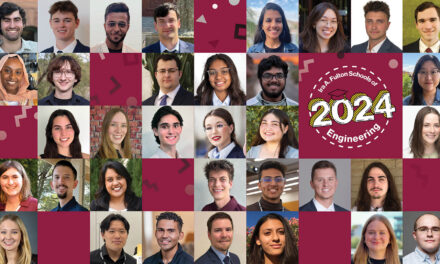
Our research: Security
As technology develops at a faster rate, there is a growing need to develop engineering systems to keep people and infrastructure secure, including securing cyberspace, developing secure communications, identifying, monitoring and reducing threats and developing self-healing systems that are resilient to attack. Our researchers are addressing issues of national defense, homeland security, border security, cyber warfare and more—devising technology solutions as well as legal, policy and social implications.
 Crisis response game simulates real disaster response
Crisis response game simulates real disaster response
Huan Liu, a professor for the School of Computing, Informatics, and Decision Systems Engineering, organized over 75 students in ASU’s first Crisis Response Game. The game was designed as a disaster simulation to experiment with the use of social media in crisis situations, data collection, task allocation and response coordination.
Students were split into two teams, one was assigned to locations and situations around campus where they were disaster victims, and the other team had to find the disaster and respond by the use of Twitter. By tracking the distressed “tweets” of the victim group, the first responders would locate and relieve them. A few volunteers were allocated as a filtering team to report the tweets of the victims to the first responders. The project was similar to many engineering assignments—a team building exercise that is representative of a real-world situation.
The results of the game identify ways that relief organizations can more effectively track, analyze and respond to a disaster using social-media based tools. This project used three specific programs: TweetTracker, ACT and BlogTrackers.
Disaster relief programs such as Humanitarian Aid and Disaster Relief (HADR), already use social media to locate and respond to people in need. The Crisis Response Game collaborators identified useful features that could be added to programs such as TweetTracker to increase the speed and efficiency of locating distressed individuals.
Several prominent organizations participated in the game. Partners included: the Quicknets Team of the Naval Surface Warfare Center Dahlgren Division; Catherine Graham of Humanity Road Inc.; Dr. Rebecca Goolsby of the Office of Naval Research; and Professor Kathleen Carley of Carnegie Mellon University.
Reliable computing advances draw recognition for engineering doctoral student
Reiley Jeyapaul, computer science doctoral student, has drawn international attention to his work to help ensure computers perform more reliably. He earned invitations to present research papers at two of the most prominent international computer science and engineering conferences.
Jeyapaul travelled to Taipei, Taiwan, to present at the International Conference on Parallel Processing in September and the International Conference on Compilers, Architectures and Synthesis of Embedded Systems in October. Jeyapaul has a master’s degree in electrical engineering from ASU.
ASU researchers to help Yahoo! users overcome Internet information overload
Two Arizona State University computer scientists are working with the leading online media company Yahoo! to make its interactive Internet news and reader-commentary services more user-friendly. Huan Liu, professor in the School of Computing, Informatics, and Decision Systems Engineering, and Xia “Ben” Hu, computer science doctoral student, will collaborate with Yahoo! Labs on a Web science research project through the company’s Faculty Research and Engagement Program.
ASU launches Security and Defense Systems Initiative
In November 2010, ASU launched the Security and Defense Systems Initiative (SDSI) bringing together complementary elements from academia, industry and government to provide innovative solutions to some of the greatest challenges in the security and defense area. SDSI addresses issues of national defense, homeland security, counterterrorism and cyber warfare, narcotics interdiction and cybercrime.
Werner Dahm leads SDSI at ASU, where he is also an ASU Foundation Professor in the School for Engineering of Matter, Transport and Energy. Previously, he was the chief scientist of the U.S. Air Force (AF/ST), a member of Headquarters Air Force and the direct science and technology advisor to the Secretary of the Air Force and the Air Force Chief of Staff.
Dahm has organized an interdisciplinary team of researchers from a multitude of fields including engineers, social scientists and legal experts. The unique nature of SDSI lies in the collaborative effort of researchers from different fields of study and its capability to support both traditional unclassified research and high-level advanced technology development efforts.
SDSI will be building on the research of several other defense system collaborations at ASU. Some of the previous research involves the measurement of exposure to radiation and methods of distinguishing harmful pathogens. SDSI intends to focus on threats that are likely to be prevalent in the next generation of warfare.
 Collaboration advances flexible, interactive computing
Collaboration advances flexible, interactive computing
An advanced “thin-film” flexible paper computer has been developed through collaborative efforts of researchers at Queen’s University in Ontario, Canada, and Arizona State University.
Called PaperPhone, it’s described as a “flexible iPhone” by its inventor, Roel Vertegaal, the director of the Human Media Lab at Queen’s University.
Hardware for a prototype of the thin-film computer/phone device has been provided by Nicholas Colaneri, director of ASU’s Flexible Display Center, and Jann Kaminski, a display engineering manager at the center.
An interactive gesture-recognition system for the PaperPhone has been developed by Byron Lahey, a doctoral student in ASU’s School of Arts, Media and Engineering, and Winslow Burleson, an assistant professor in the School of Computing, Informatics, and Decision Systems Engineering.
Vertegaal says the invention will spark a major advance in interactive computing, opening the path to a new generation of computers that are more lightweight and flexible.
The PaperPhone does everything a smartphone does, including store books, play music or enable phone calls. The flexibility of the display makes it more portable than any current mobile computer. In addition, the paper computers require no power when not in use.
The development team is also collaborating with E Ink Corporation, the world’s largest supplier of displays to the e-book industry.




































